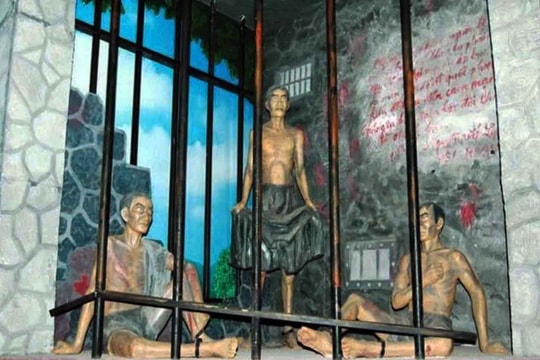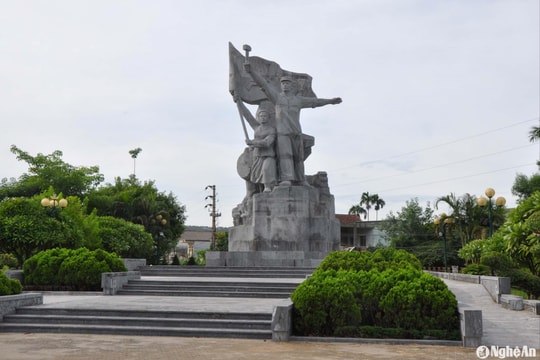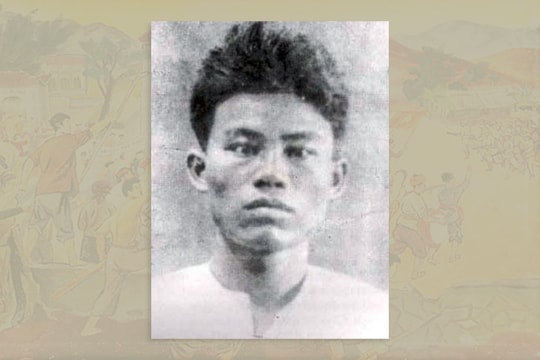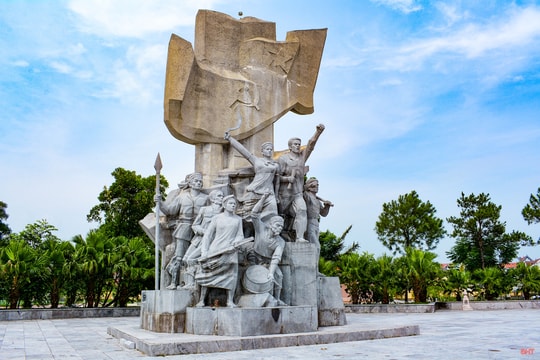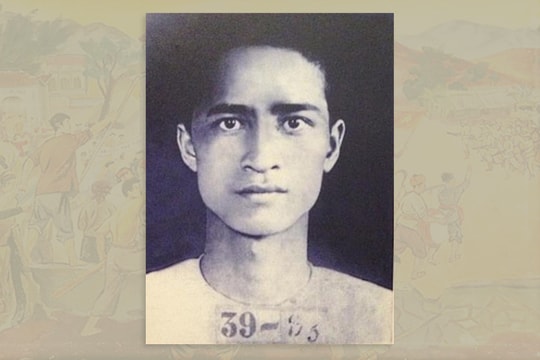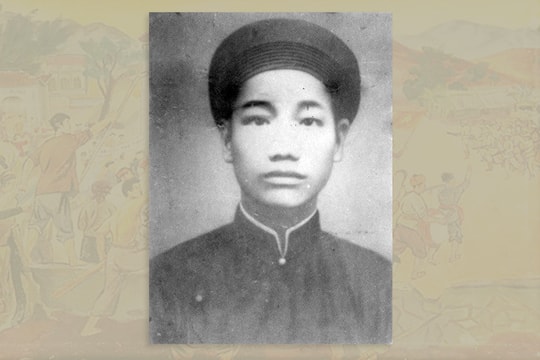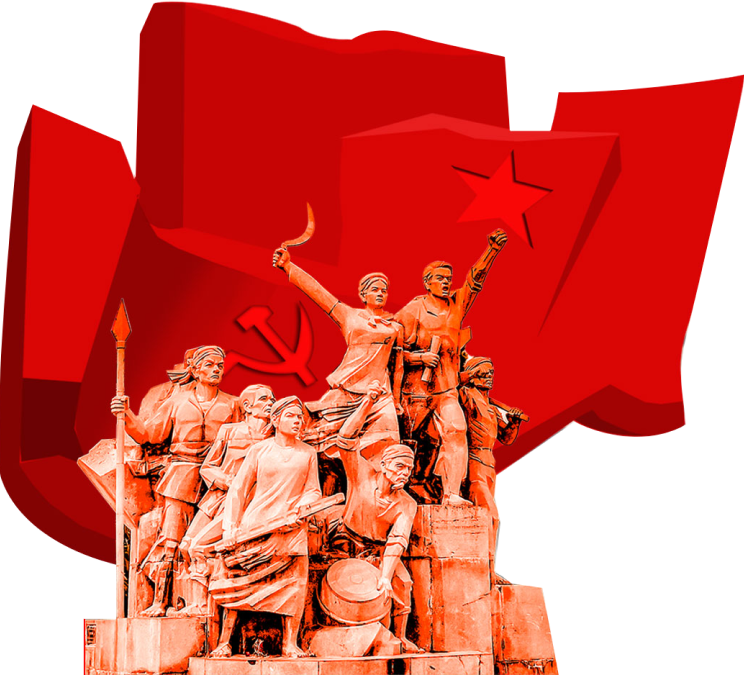About Trung Can...
It is not necessary to classify it as a ghost land or a sacred land to have a strong source of culture; and, even though today people's lives still rely heavily on the simple rural livelihood, the lifestyle and awareness of preserving the cultural and spiritual heritage left by their ancestors still appear, creating an unexpected attraction for visitors from afar. That is to say, the countryside of Nam Trung (Nam Dan) in the lower Lam river with lingering alluvium...
The late afternoon sun is hazy in the late winter. But this side of the river is still not a lazy, quiet scene. Rong Market is bustling with buying and selling, the roads are being upgraded and expanded. The loudspeakers broadcasting the commune's year-end crop promotion policy are bustling throughout every corner of the village. Taking us to visit Trung Can communal house, Ms. Le Thi Hoa - an officer of Nam Dan district's Cultural and Information Center affirmed: "Nam Trung is a locality that, if the existing relics associated with the tradition of studiousness and revolution are well promoted, will become an attractive destination in the system of tourist destinations in Nam Dan district...". Right after Ms. Hoa's mobile phone call, the keeper of the communal house, Nguyen Van Tuat, 68 years old, living in hamlet 8 where Trung Can communal house was built more than 220 years ago (1782), quickly appeared. Respectfully opening the communal house door, Mr. Tuat excitedly said: "The people of Nam Trung are very excited that recently a foreign project group came to survey and invest in renovating the communal house."
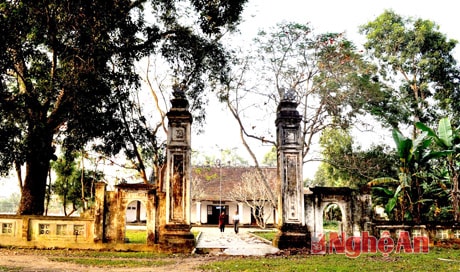 |
| Panoramic view of Trung Can communal house in Nam Trung commune (Nam Dan). |
In terms of architectural value, Trung Can communal house with its “sophisticated architectural art” is considered one of the largest and most beautiful ancient communal houses in the country with intact grounds and three-door gate. The communal house has a sanctuary to worship the tutelary deities and the famous scholars who founded the communal house. Today, on the first and fifteenth of each lunar month, the spiritual incense of the villagers is still thick. Mr. Tuat’s life has been attached to the communal house since his youth. For the generation who grew up and recognized the day of the government taking over in 1945, Trung Can communal house is still a meeting place imbued with the traditional Vietnamese village life. The communal house is also where Mr. Tuat went to elementary school, and when he grew up, he joined the Youth Union, the Youth Union... Mr. Tuat recalled: “In 1954, after the Dien Bien Phu Victory, the communal house was also chosen as the place to house a group of French prisoners of war. During the flood season that year, when the water rose and washed away all the sacrificial objects in the communal house, a group of French soldiers was mobilized to help people escape the flood. They were very strong, some prisoners even carried a whole calf to the kitchen for the people... During the war against the US, there were also a few Central and provincial agencies evacuated and stationed here for a while. But the happiest thing was in the early 1960s, Trung Can communal house was a liaison station for troops advancing to the South; every night the communal house was filled with the sound of military and civilian songs.”
I was fascinated by the rafters, four-pillars, and wooden horizontal lacquered boards carved with sophisticated patterns, with the majesty of dragons and phoenixes, the elegance of wind and clouds, and the serenity of the agricultural landscape of the alluvial plains... Ms. Hoa told me an interesting detail: the communal house was built by talented carpenters of the old Trung Can village. No wonder people from 9/14 hamlets of Nam Trung commune located on the land of the old Trung Can village are still famous for their masonry and carpentry skills, and have established many groups of workers to work far away in Laos. Over 200 years, through several generations, the communal house has somewhat degraded but is still majestic in the countryside. In front of the communal house are large, old acacia trees that are as old as the gatekeeper Nguyen Van Tuat, with rough old trees and green canopies adding an ancient look to the communal house scene.
I guess before Trung Can communal house also had a banyan tree and a ferry? The books do not record it and the oldest person in Trung Can today has never heard of it. But before the "change of things" about a hundred years ago, the communal house still had a graceful river flowing through it. This river was gradually deposited with alluvium to form a beach; and the charming water gathering is certainly evidenced by the moss-covered tomb located on Gia Rao field in front of the communal house of the first tutelary god worshiped at the communal house and also the founder of Trung Can land: Doctor, famous general with many illustrious martial arts in the Le Trung Hung period - Mr. Tong Tat Thang (the death of Tong Tat Thang and the subsequent departure of his family and all his descendants from Trung Can land is a questionable issue recorded in the genealogies of the Tong branches in Nghe - Tinh, but it can still be affirmed that Trung Can is the homeland, the birthplace of Tong Tat Thang with many relics still preserved related to him).
Next to Trung Can communal house is the memorial area of the late Minister of Public Security Tran Quoc Hoan - an outstanding son of Nam Trung commune. The memorial area was built spaciously with planning, architecture with bold ancient features in many documents since 2012, now it has also become a tourist attraction, a place to educate revolutionary traditions very meaningfully. Mr. Ho Van Lien, 71 years old, a normal but careful mason who participated in building the tomb of Mrs. Hoang Thi Loan on Dong Tranh mountain since 1983, remembers the day when the people of the Project Board for the construction of the memorial area of the late Minister Tran Quoc Hoan came to see him in hamlet 7, Nam Trung commune, immediately "promoted" him to be the head of the construction board and after the memorial area was completed, he was assigned to be the guard, burning incense here, which is also a reward from his admiration and respect from childhood to adulthood, for the revolutionary ancestors. Mr. Lien said: "The memorial area of Uncle Tran Quoc Hoan is currently attracting the attention of many visitors to Trung Can communal house, and is considered a must-see place because of its architectural beauty, rich documents and cultural significance"...
Returning to Rong market, going up to the old Duong Lieu area, now also part of Nam Trung. “Quan Trung Can, people of Duong Lieu” is a dialect saying that people of Trung Can village have a tradition of learning, people of Duong Lieu village have the will to “resist the odds”, continued by the patriotic spirit of rising up to fight with the Party later. This is the hometown of comrade Nguyen Tiem, the first Secretary of Nghe An Provincial Party Committee (died at the age of 21, while being a member of the Central Party Committee Standing Committee in charge of propaganda work). Currently, the memorial house of comrade Nguyen Tiem is the original old house in the garden of the house where he was born.
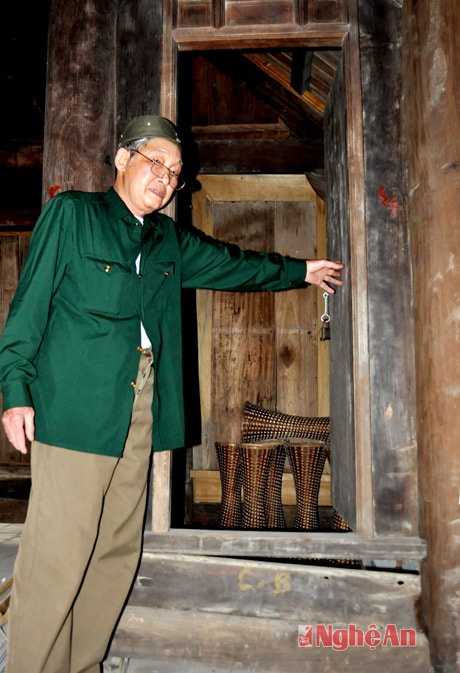 |
| Mr. Nguyen Van Ty (Nam Trung - Nam Dan) introduced the room where comrade Nguyen Tiem often held secret meetings. |
Ms. Le Thi Hoa said that the house and the wall surrounding the flower-strewn yard and the garden with perennial plants were restored almost to their original state. I entered the tiled gate, followed the path with two rows of neatly trimmed tea trees, and imagined the days of the first Provincial Party Secretary's revolutionary youth, who had left his footprints many times coming to this house, meeting with his comrades in the small room in that 5-room lim house. Also right here, Mr. Nguyen Chinh - President of the Nam Trung Friendship Association, father of comrade Nguyen Tiem, decided to sell 50 hectares of rice fields for 40,000 Indochinese piastres so that comrade Nguyen Tiem could give them to the organization to buy a printer for documents and leaflets... Mr. Nguyen Van Ty - a descendant of the Nguyen Duong Lieu family, now assigned to look after the memorial house, said that there are about 20 households left in the village, those who followed the example of studying and fighting for the revolution of their fathers and brothers, all did business and work successfully, many of them are high-ranking military officers and cadres...
In the pale afternoon light of the old courtyard, I heard comrade Nguyen Tiem's relatives tell stories about his youth as well as stories related to his life and activities. If it weren't for his younger brother, Mr. Nguyen Nhat Pho (aka Ly Thien Tuan), who was a close friend of the late Minister Tran Quoc Quoc Hoan, who searched through the top secret archives, future generations today would not have had the full understanding and pride of comrade Nguyen Tiem. But anyway, I would like to give readers a day to return to Nam Trung, visit Trung Can communal house, thoroughly visit the relics here, and leisurely drink a bowl of green tea, taste the fruits in the garden of comrade Nguyen Tiem's memorial house to continue listening to many interesting stories related to his heroic revolutionary life...
According to official history books, nearly 2000 years ago, the land of Nam Trung was also called Trang Can Cung, belonging to Nam Hoa Thuong commune, Nam Hoa canton, Thanh Chuong district. At the beginning of the 19th century, Trang Can Cung was separated from Nam Hoa Thuong commune to become Trung Can commune and still belonged to Nam Hoa canton, Thanh Chuong district. At the end of the 19th century, Nam Hoa canton was changed to Nam Kim canton, Trung Can commune still belonged to Nam Kim canton, Thanh Chuong district. In 1910, Nam Kim canton was transferred to Nam Dan district. After the August Revolution of 1945, the two communes of Trung Can and Duong Lieu were merged into today's Nam Trung commune.
Trung Can Communal House is associated with the merits of three ancestors of the Nguyen Trong Trung Can family, father and son, grandfather and grandson, who passed the third class of Doctorate in the Le Trung Hung period; including Mr. Nguyen Trong Thuong who passed the third class of Doctorate in 1712 (stele of the Temple of Literature - Quoc Tu Giam); Mr. Thuong's second son, Nguyen Trong Duong (Dang), passed the third class of Doctorate in 1769; Mr. Thuong's eldest grandson, Nguyen Duong (Nguyen Trong Duong), passed the third class of Doctorate in 1779...

